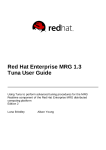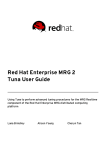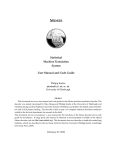Download RTAI user manual
Transcript
RTAI 3.3 User Manual rev 0.2 RTAI User Manual 3.3 - pag 1 Chapter 2 Copyright info Chapter 2 Copyright info This document, is copyrighted © 2006 by Giovanni Racciu <[email protected]> and Paolo Mantegazza <[email protected]>. Part of this documentation has been copied and derived from README files included in the RTAI3.3 distribution and its CVS repositories. The RTAI-doc project makes no representations or warranties with respect to the contents or use of this manual, and specifically disclaims any express or implied warranties of merchantability or fitness for any particular purpose. The RTAI-doc project reserves the right to revise this publication and to make changes to its content, at any time, without obligation to notify any person or entity of such revisions or changes. This work is licensed under the Creative Commons Attribution-NonCommercial-NoDerivs 2.5 License. To view a copy of this license, visit http://creativecommons.org/licenses/by-ncnd/2.5/ If you have questions or suggestions about this document, please send an email at [email protected] or contact the RTAI-doc project by use of the mailing-list. Preliminary version We have decided to start publishing this document, even if it contains only few chapters, as we think it may be very useful to the RTAI community. We will keep releasing new versions of this document as soon as new chapters are available. RTAI User Manual 3.3 - pag 2 Chapter 3 Getting RTAI Chapter 3 Getting RTAI Download RTAI – The CVS repository The very first place to look for the latest stable release is the main RTAI website http://www.rtai.org. On the first page there is always a link to the tarball with all the source code needed to compile and install the actual released version of RTAI; this tar archive also contains the certified patches for the GNU/Linux kernel; you basically only need this to get started. Illustration 1: The main RTAI webpage While if you would like to test new functionalities or if you are looking for a minor bug fix which has not been back ported yet to the official stable version, you may want to download the latest version from the CVS. Doing this is just a matter of accessing the public CVS repository of this project which is also browsable on-line at the following address http://cvs.gna.org/cvsweb/?cvsroot=rtai. It is suggested browsing it to locate better what is needed and to get familiar with the naming scheme used by RTAI. Once you have found what you need to download on your local machine you have to access the CVS anonimously with the following comand: cvs -d:pserver:[email protected]:/cvs/rtai co <modulename> The module you wish to check out must be specified as the modulename. When and if prompted for a password simply press the Enter key. The available modules are: Module Name Description Kilauea Closed branch Magma This is the development version rtai Empty Showroom It contains all the available examples Stromboli Closed branch Vesuvio Closed branch Vulcano This is the stable version RTAI User Manual 3.3 - pag 3 Chapter 3 Getting RTAI Illustration 2: The browsable CVS repository Further information on how to access the CVS can be obtained at the following address https://gna.org/cvs/?group=rtai 3.1 The showroom repository As mentioned before one module is named showroom and it contains a lot of source code examples covering almost all the features available in RTAI. It's important to take into account that inside the main RTAI source tarball there are just a few basic examples, in the testsuite directory, to allow checking that the installation went well. That is done mainly to keep it small and to allow experienced RTAI user to avoid downloading it over and over. For such a reason if you are approaching RTAI for the very first time, downloading the showroom is a necessary/mandatory step. The showroom is also very important for knowing about newly developed features which maybe present in the latest release and that are always explained by a brand new example(s). In order to compile the examples from the showroom, you have to make sure that $prefix/bin is in your PATH variable, where $prefix represents the RTAI's installation root (as you will see in the next chapter, by default prefix is set to /usr/realtime). This is important to let the Makefiles and the runfiles of each single example access the rtai-config utility. To compile and execute the examples just run the make and the ./run script located in its directory. The showroom examples directory scheme and names are also very clear to help you understand immediately the purpose of a specific example. All the examples are divided into two main branches that are “kern”, which contains the examples related mainly to RTAI kernel mode development and “user”, for user space. Naturally since RTAI schedulers allow full kernel/user space inter/intraoperability you will find also mixed applications in both branches. Last but not least all the examples have a README file that explains better its behavior and its design. RTAI User Manual 3.3 - pag 4 Chapter 4 Installation and calibration Chapter 4 Installation and calibration Installing RTAI Once you have downloaded the latest tarball it's time to start configuring and compiling RTAI, but before explaining the entire procedure I'd like to introduce some of the most common pitfalls to allow a smooth installation. As you have already learned, RTAI is made of two separate parts; the patch for the abstraction layer and the services. Any RTAI release comes with several patches, which will be described later, but all of them are for a specific vanilla GNU/Linux kernel. This means that RTAI is designed to run on a standard Linux kernel which can be downloaded from http://www.kernel.org and not on the kernel's source code that comes with the most common distributions and they are sometimes (read:almost/always) heavily patched and this can lead to incompatibilities, strange warnings and if successfully compiled to weird behaviors. For this reason always get a standard fresh kernel. Another recurring question/error is that the kernel compiled with your distribution has a lot of features which are available as modules or static (compiled with the kernel) and you must somehow simulate this, also with the RTAI patched kernel, if you want to have it running transparently. Doing so is generally just a matter of importing the configuration file of the actual running kernel. It can be found under the /boot directory as .config or as config-{kernelverions-tag}. If you don't want to compile the kernel starting from that file, which will generally lead to a longer process and a bigger file, you have to pay attention to enable all the features your hardware requires to work properly. This includes the file system, the network card and all the options needed; failing to enable the right features will produce a kernel with missing functions and wrong behavior and in the end you will not be able to fully use the system (as expected). Last but not least, always keep your old working kernel and modules available as entry in your boot loader so that you can easily access the system if something goes wrong. 4.0 Introduction RTAI uses only the leanest and fastest RTAI+Linux combination now; it dispatches real time interrupts immediately. Moreover within such a scheme i386 has the possibility of completely avoiding the dispatching of critical internal timers and interprocessor scheduling interrupts by vectoring them directly to their handlers. Such an option strongly enhances performances on low end machines and comes by default. You can disable it while configuring RTAI though. See the related configuration helper. This will require you to patch Linux just with patches found within this distribution. 4.0.1 Patching and compiling the kernel The very first step is to patch and build a vanilla Linux kernel tree with the RTAI support. The patches, for different architectures and for specific kernels are located under: rtai_dir/base/arch/<specific_arch>/patches Once you have chosen and defined one patch that matches your kernel version it's time to apply it by typing the following commands: cd $linux_src_dir patch -p1 -b < rtai_dir/base/arch/i386/patches/hal-linux-2.6.15-i386-1.2-00.patch This example applies the latest patch to a GNU/Linux kernel 2.6.15 and it's one available in RTAI 3.3. Note:Latest kernels are available with additional numbering scheme, for instance at the time of this writing the latest stable is 2.6.16.11, but as you will notice the patches are limited to the first 3 numbers. Apparently the additional last number should not generate problems and the RTAI User Manual 3.3 - pag 5 Chapter 4 Installation and calibration kernel can be patched and compiled, but it's better to consider using only the official version indicated by the patch, because it is the only one fully tested and therefore supported. It's common to place the Linux kernel source tree under /usr/src/linux (note that it's a link to the real directory) but if you would like to keep this build separated from the whole system you may create and put everything into a specific directory. If this is your case you need to specify this directory during the RTAI configuration step. Immediately after having patched the kernel you need to configure and compile it. The configuration depends mainly on your specific needs, your hardware's spec and the devices which are on your system; it's a good idea to start the configuration by importing the existing .config file which is shipped with the distro. Generally you can find this file under the /boot directory with a name config_xxx_yyy (even if this can be different according to the distro you choose); simply copy it into the patched kernel dir and rename it as .config. A make oldconfig command will do the rest, by importing all the existing configuration. Beside all the specific options you may enable and/or disable there are several of them which must be configured to allow RTAI to work properly They are: “Use register arguments” under “Processor type and features” must be disabled “Interrupt pipeline” under “Processor type and features” must be enabled (but, unless you want to control/debug the patch behaviour) is better to disable statitics gathering as it adds some overhead) “Module versioning support” under “Loadable module support” must be disabled Note: Attention must be taken for the APIC (Advanced Programmable Interrupt Controller) configuration; the option is located under “Processor type and features”. In the previous versions the APIC had to be disabled on UP machine, and could only by used on MP ones. With the latest RTAI release the APIC can be enabled and used with success even on UP machines and with this option enabled the system will benefit of faster timer reprogramming in oneshot mode and lesser overhead. Anyhow if the APIC is configured/enabled in the kernel but it's not present on your hardware RTAI will complain and give you the following error: RTAI[hal]:ERROR, LOCAL APIC CONFIGURED BUT NOT AVAILABLE/ENABLED in this case you have to disable the option and recompile/reinstall the kernel, its modules and RTAI. Note:Before running the compilation for the kernel you may want to configure rtai first (see 4.1.1) as the configure script will advise if any option for the kernel is wrongly configured. This document does not cover any other specific issues regarding the kernel compiling and installing procedure which you will easily find on the Internet and limits the instructions to the following easy steps: $ make xconfig $ make $ make install If you configured any option as a module you will also have to run: $ make modules_install RTAI User Manual 3.3 - pag 6 Chapter 4 Installation and calibration Illustration 3: Linux kernel configuration: make xconfig ("Interrupt pipeline") Note:Once the kernel and the modules have been installed it maybe necessary to run a mkinitrd script which will create an initial ramdisk for correctly booting the machine. Failing to generate it won't allow the system to boot. You should also define the new kernel and it's parameters as a (new) entry inside the configuration file of your boot loader. Again, it's important to keep the old kernel entry available to avoid problems if something goes wrong with the new RTAI-Kernel. Note: If you use LILO you should also run the lilo command, while if you use GRUB the entry in the menu is enough. The LILO command may also be executed automatically according to specific distro's settings. 4.1 Standard installation procedure The RTAI build system is a merge of Linux's Kconfig with autoconf/automake/libtool. Therefore, you can either build RTAI: 4.1.1 Interactive configuration The interactive configuration is the preferred and easier way to configure RTAI especially for a first time user. All the options are browsable, selectable and well documented. To run the interactive configuration you have to: 1) Into the source tree like with 3.x (your_source_dir == your_build_dir). Just run either: $ make xconfig # (Qt-based) $ make gconfig # (GTK-based) $ make menuconfig (dialog-based) RTAI User Manual 3.3 - pag 7 Chapter 4 Installation and calibration Illustration 4: RTAI - make menuconfig Save your configuration, wait for the shell prompt to come back after the configuration script has fully finished, then run "make". Check the output of the scripts to verify if there is any error. Generally the script is kind enough to explain you how to correct any errors. 2) Outside the source tree (preferred way). From your fresh build directory, either run: $ make -f $source_tree/makefile srctree=$source_tree xconfig $ make -f $source_tree/makefile srctree=$source_tree gconfig $ make -f $source_tree/makefile srctree=$source_tree menuconfig If you are using a version of make >= 3.80, then you can even get rid of the "srctree=$source_tree" setting. 4.1.2 Non-interactive configuration Since RTAI 3.x has autoconf inside, people needing automatic non-interactive configuration can directly use the provided GNU configure script for this purpose. The available configuration switches can be listed by running ./configure --help. Some configuration targets in base/ can either produce a module, or be statically linked to the RTAI schedulers. Either pass "m" for the modular build to their respective --enable-xxx switch, or "y" for selecting the built-in mode. 4.1.3 Recycling a configuration file If you are an experienced RTAI user, you can also recycle an existing .rtai_config file from a previous build by running: $ cp -rp $old_builddir/.rtai_config \ $new_builddir/.rtai_config $ cd $new_builddir $ make -f $source_tree/makefile srctree=$source_tree oldconfig 4.1.4 Selecting alternate compilers Newest compilers sometimes are generating errors during the build process; for this reason it is possible to specify an alternate one. The compiler selection must be done at configuration time. There is only the need to pass the right values for the standard environment variables CC and CXX, respectively for compiling C and C++ source files. In any case, using a GCC tool chain is mandatory. When unspecified, these variables's values respectively default to "gcc" and "g++". WARNING: this selection is not aimed at toggling the cross-compilation mode on. In order to do so, please refer to 4.2 RTAI User Manual 3.3 - pag 8 Chapter 4 Installation and calibration Examples: # Start configuring using the Qt-based GUI with alternate compilers $ make xconfig CC=/my/favorite/c/compiler CXX=/my/favorite/c++/compiler # Reconfiguring a previous build tree, changing the compilers on-the-fly. $ make reconfig CC=/my/favorite/c/compiler CXX=/my/favorite/c++/compiler # Rebuild all [and optionally install] $ make [all [install]] 4.2 Cross-compilation support To enable the cross-compilation simply add ARCH and CROSS_COMPILE variables as usual to the standard command lines, e.g. $ make -f $source_tree/makefile ARCH=arm CROSS_COMPILE=arm-linuxNames of available architectures can be found under base/arch/*. 4.3 Installing the software When the standard (or cross-) compilation has finished with no errors you may proceed to the installation by typing the following commands: $ cd $builddir $ make install Everything needed to use the RTAI distribution will be copied to the default installation directory, or to the one specified during the configuration of the build tree. From now on, you should be able to refer to the installation directory as the root of a complete standalone binary RTAI distribution. The RTAI programs can also be installed under a temporary staging tree by passing the standard DESTDIR variable to "make" while installing. e.g.: $ make install DESTDIR=/mnt/target this command will create a standard RTAI hierarchy under /mnt/target, keeping the original prefix information unmodified. If the installation directory selected at configuration time was "/usr/realtime", then the command above will put the RTAI binary distribution under /mnt/target/usr/realtime. WARNING: running "make install" it is required to run several standard RTAI programs correctly. RTAI 3.x enforces the actual split between the source distribution tree, the build tree where RTAI is going to be compiled, and the final installation directory where RTAI programs can be run. In any case, you should only rely on the installation directory contents to run RTAI programs. Note:You should also add to your PATH variables the bin directory of the RTAI installation. If you did not modify the target dir it is /usr/realtime/bin. This is necessary to access directly some files required to compile and run the programs. 4.4 Compiling parts of the tree RTAI developers may want to recompile just single parts of the tree from times to times. The automake-based build system allows it: just go to the proper directory level, then issue "make", as usual. This process will recurse as needed. RTAI User Manual 3.3 - pag 9 Chapter 4 Installation and calibration 4.5 Changing the configuration Each time you want to change your configuration, just run "make xconfig|gconfig|menuconfig" in your build dir, then "make" (or "make all"). If you only want to rerun the "configure" script using the current RTAI configuration, just run "make reconfig", there is no need to restart any GUI for that. When invoked for the first time in an empty build directory, the default "make" goal is "menuconfig" in a regular terminal, or "xconfig" in an emacs-term. 4.6 Modifying the autotool template files If you have to change some template files used by any of the autotools (i.e. Makefile.am, configure.in, acinclude.m4), then you will need the following packages to rebuild the derived files: - autoconf 2.59 - automake 1.9.2 - aclocal 1.9.2 - libtool 1.5.8 4.7 Checking the performance Before using the integrated calibration tool it's a good idea to verify the overall performances of your system and find out if it is suitable for real-time applications. Doing so it's just a matter of running the latency test which is available for kernel and user mode. It verifies the architectural latency and jitter, up to the scheduling of a task. When used with the hard timer in oneshot mode it can serve as a fine tuning of the average real-time scheduling latency. In oneshot mode the idea is to measure the difference in time between the expected switch time and the time when a task is actually called by the scheduler. In periodic mode however the variations of the task period are used as measures of the scheduling latency/jitter. The reason for such a choice are that there will be always a drift because the timer interrupt is based on a time baseline that is different from the one used to carry out measurement calculations; in case of a very good calibration (see next paragraphs) such a drift can be made very small and as far as there is no loss of timer interrupts there will be no drift in periodic mode, unless the hardware goes astray, so period variations are valid measures. The execution is fully customizable at insmod time as it is possible to set up, the timer mode, the timer period, the averaging time, the per average time or overall worst cases and the use of the FPU (with some calculations). This test is located, after having installed RTAI under install_dir/testsuite/kern/latency or install_dir/testsuite/user/latency. Running the ./run script will start it and the following results will appear: RTAI User Manual 3.3 - pag 10 Chapter 4 Installation and calibration Illustration 5: latency test in kernel mode with bad results As you can see in this example the test shows weird results, which obviously aren't acceptable for a real time applications. To better understand why this can happen you should be aware of a series of “latency killer” conditions which may be present on your system. Among them there are: -heavy DMA activities (like the hard-drive or other PCI devices) -the use of an accelerated x-server -the USB legacy support -the power management (both APM and ACPI) -CPU frequency scaling -SMI -plus many others The “latency killers” cause unpredictable timing results and that is incompatible with the concept of real-time. As a workaround you may start disabling them both in the BIOS and in the kernel configuration. You may find specific informations on how to disable the functions at kernel level under linux/Documentation kernel-parameters.txt. Once you have disabled the suspected “latency killer” run again the test to see if it was the guilty one. Illustration 6: latency test in kernel mode with (preliminary) acceptable results In the above illustration, after having disabled the DMA for the hard-drive, the latency test runs fluently without overruns and with acceptable performances. All the results displayed by the latency tests are in nanoseconds. It's a good idea to run this test for a long period of time while stressing the system, like writing on the disks, accessing the network and playing with the graphical user interface to obtain the real timing capabilities of your system and to find out any possible additional source of latency generation. Once the test has been successfully executed you may proceed to calibrate RTAI to try decreasing the RTAI User Manual 3.3 - pag 11 Chapter 4 Installation and calibration latencies and to obtain a more deterministic system. Note: Always run both tests (kernel/user) for understanding the overall latency of your system. In user mode you should expect a slightly worse result, but not so bad, compared to its kernel brother. 4.7.1 The “switches” test There is another important test-tool, which is placed in the testsuite directory, that can provide you some informations about the maximum time RTAI needs to disable the interrupts. The software is under the testsuite/kern/switches (or user/switches) and checks for the task switching timings. To do so the utility uses a repeated sequence of suspend/resume and semaphore signal/wait, with the FPU support and under a relatively heavy load (about 10 tasks). Assuming the kernel has been properly patched and executed as described before, the results gives you an idea about the architectural switching time. If the values are too high you should verify again if there is any latency killer left. Moreover you will see that the switching time figures a far below the worst case latency with respect to the one will get by running any RTAI calibration tool like task scheduling latency or the interrupt only latency check, especially if any Linux load is applied. That is a clear evidence that the real latency limitation is very seldom due to RTAI but is an intrinsic drawback of using a General Purpose CPU (GCPU) for real time applications. To run this test simply execute the ./run script located into the directory. You will obtain a result similar to the following: Illustration 7: the switch test 4.7.2 The “preempt” test This is the last test which is in the testsuite directory. It is designed to verify the schedulers under intense load. You may look at this test as a stress utility. This software combines the latency calibration task with a fast and slow task to have two levels of preemption, nesting on an odd number of tasks. You may verify what happens by launching the display utility which will show the min/max/avrg jitters of the latency check task, next to highest priority, and of the slow task, at the slowest priority. Reasonable jitters are a clear indication of preemption. This test on a UP machine will eat up to the 75% computing power of your machine so you may want to decrease the ticking to obtain less load. This means that you also have to adjust the parameters of this test according to your machine spec to avoid unfair locking of the scheduler. To apply some additional stress to your machine you may want to use at least one of the following commands: ping -f whatever.address.youlike pint -f localhost top on one screen and maybe another on a X screen a “while “true”; do ls -lR / > list; done” a “while “true”; cat /proc/interrupts; done” RTAI User Manual 3.3 - pag 12 Chapter 4 Installation and calibration launch at least a dd command to access heavily the hard-drive It is also suggested to run run this test for several time (at least a couple of hours) to get the real picture of your machine. This test is also available in the user subdirectory. 4.8 Using the integrated calibration tool for i386 architectures RTAI 3.x comes with a brand new calibration tool which should help you determining if your hardware platform is up to the hard real-time duties and to tune it to its best. You can find this tool under $installdir/calibration. To obtain all the options just type: $ ./calibrate –help To run this tool the following modules should be already loaded: 1) 2) 3) 4) rtai_hal rtai_lxrt or rtai_sched rtai_fifos rtai_calibrate Note: The rtai_lxrt must be inserted if you want calibrate, for further use, the Linux threads in kernel; while the rtai_sched is for using the specific RTAI kernel tasks, along with Linux threads in kernel. You can also execute the ./run script to automatically load the modules and launch the tool. This scripts also accepts some options like: calibrate_irq and calibrate_user. The main purpose of the calibrate tool is to show you how to fine tune your system as it gives informations about the 8254 oneshot mode, the CPU frequency, the APIC frequency, the latency and the worst case interrupt locking/contention. There is a complete README file located under base/arch/i386/calibration which contains all the details about each calibration procedure but briefly we may say that the 8254 Calibration evaluates the time it takes to write two bytes to the 8254 timer. The APIC Frequency calibrates the APIC timer against the 8259 timer. The CPU Frequency test calibrates the cpu clock against the 8259 timer. You can run the two above tests together simply by typing calibrate -b. The Latency test calibrates the scheduling latency of RTAI schedulers with oneshot timers, to allow more precision for timed tasks. The last important test is the interrupt locking/contention (calibrate -i); more and more motherboards are being sold with chipsets that have hardware optimizations allowing locking the bus, maybe up to few milliseconds. Without judging if such a way of working is acceptable, it make make it appear to improve overall average performances in general applications, it surely dooms real time usage. Often what RTAI users see, are large scheduling jitters and they start hinting at bugs that likely do not exist. This check is aimed at helping in tracking such a problem. It measures interrupt latency by using the TSC on the timer interrupt, machines without TSCs are old enough to have no optimizing chipsets. Thus they do not have such a problem. The only module implied is rtai.c, there is thus no scheduling but just interrupt dispatching, that should have latencies in the range of 20/30 us worst case. So if you see something too much higher then play with its configuration parameters, with those of Linux as well, and you may end in buying another board. The worst interrupt latency is displayed at the end of the run, which comes when you type "Ctrl-C". Note that it is possible to check it also on a scope by defining using "-sy" and connecting the scope to the first output bit of the parallel port. See also the README.SMI file in the same directory for some clues that might help with some INTEL chipsets. 4.8.1 Playing with the showroom calibration tool In the showroom repository there is a modified version of the calibration tool; it differs from the standard one mainly because it can calibrate both RTAI ktasks and Linux kthreads and it is RTAI User Manual 3.3 - pag 13 Chapter 4 Installation and calibration more interactive and therefore easier showroom/v3.x/kern/i386/calibration to be used. This test is placed under: Illustration 8: Interactive calibration All the available tests can be executed without exiting and restarting the process, thus allowing a faster and more clear calibration of your hardware. To choose a test simply type the “Upper case character” as indicated in the list and insert, if required, the proper setup values. With this tool you can also find out what is the minimum period the machine can handle without freezing. This test is not really for calibrating the hardware but it's important to give you an idea on the maximum achievable performance. To discover this limit, simply run a bus Lock check with a decreasing period up to the machine freezing. Note: You should always run the calibration test for a reasonable period of time and under an average system load to discover the real values or at least the get the ones closest to the system true performances. 4.8.3 What to do with the results As you learned, the results will give you some advice regarding your hardware platform; now it is important to use them to customize your RTAI installation to achieve better timing values. First of all we need to understand that even if calibrating is not strictly necessary, as RTAI will run happily even without it, it's much better to configure the machine at it's best so that you can get the maximum from it. RTAI has some definitions, inside the source code which can be used to assign the right values which came out from the calibration. These values, like the 8254 setup time, the APIC frequency (if the APIC is present) and the CPU frequency must be inserted by hand in the asm-i386/rtai_hal.h file while the latency definition is defined in the rtai_config.h file. After having modified the source you obviously need to recompile an reinstall RTAI before the changes can take effect. RTAI User Manual 3.3 - pag 14 Chapter 4 Installation and calibration Illustration 9: Editing the rtai_hal.h file to insert the real calibrated values. These values can also be passed to the modules, thus avoiding recompiling RTAI and allowing an easier/portable installation on different machines. The timer setup and the latency can be passed to the scheduler module while the APIC and CPU frequency to the rtai_hal module like in the following examples: Get the result coming out from calibrate -c which is the CPU Frequency and type: insmod rtai_hal.ko rtai_cpufreq_arg=996677084 If the APIC is present run calibrate -a and pass the result to rtai_hal with: insmod rtai_hal.ko rtai_apicfreq_arg=VALUE_FOR_THE_APIC The 8254 Calibration and the Latency (calibrate -r and -k or -u) should be passed to the scheduler rtai_ksched or rtai_lxrt insmod rtai_lxrt.ko SetupTimeTIMER=xvalue Latency=yvalue or insmod rtai_ksched.ko SetupTimeTIMER=xvalue Latency=yvalue Note: The latency should be calibrated to find out an average value which has to be acceptable both for kernel and for user, even if, as you will notice, the differences are very small. While, if your own RTAI project, is based only on kernel or only on user mode, just check the latency for the selected scheduler. At the end you may want to run again the latency test and the calibration to verify the latest performance level after the tuning procedure. RTAI User Manual 3.3 - pag 15 Chapter 5 RTAI schedulers Chapter 5 RTAI schedulers Schedulers and hard real time in kernel/user space. The scheduler is the heart of RTAI, it provides trough a series of mechanisms the real-time capabilities which are peculiar to this project. By using the RTAI scheduler the process can meet hard real time constraints and being able to run deterministically, that means that the process can be executed precisely as designed and not limited by the general purpose GNU/Linux scheduler. A real-time process which links to RTAI can therefore used to control complex applications, such as numerical control, industrial process and any complex task which requires “correct” scheduling. RTAI provides symmetric hard real time services inter/intra user/kernel space. Such a support comes through two schedulers, that at the moment are called rtai_lxrt and rtai_sched. They can operate in both user and kernel mode and they differ only in relation to the objects they can schedule. That means that rtai_lxrt is simply a GNU/Linux co-scheduler, this means that it supports hard real time for all Linux schedulable objects like processes/threads/kthreads. The rtai_sched instead supports not only hard real time for all Linux schedulable objects, like processes/threads/kthreads, but also for RTAI own kernel tasks, which are very light kernel space only schedulable objects proper to RTAI. So while in user space there is no choice but scheduling Linux processes and threads, one could ask her/himself what is worth the redundancy of having different scheduling objects in kernel space, as at a first glance they will afford much the same functionalities. Understanding the advantages and the disadvantages of one scheduler with respect to the other is important to decide which one to use and how to implement your own real time software project. Please remark that for user space only applications the two schedulers are the same. So the idea that user space means LXRT is wrong as RTAI is LXRT always. The different names of the schedulers are meant just to distinguish the schedulable objects available in kernel space and to ease those that want to use Linux schedulable objects only and everywhere. Thus let's say immediately that the big advantage of RTAI's light kernel tasks is their fast switching time with respect to Linux kernel threads, but on the other side it's important to know that they operate outside any Linux environment. This behavior requires some special care if one needs to inter-operate with Linux. This attention has not to be payed with Linux kernel threads as they offer the advantage of being fully integrated in the Linux environment and ease any needed RTAI Linux interaction. So unless there is a real design constraint using the GNU/Linux co-scheduler is the best choice; or at least is the one which gives more freedom to the development process. 5.1 How the scheduler(s) works That said let's see first how any of the 2 available RTAI schedulers can become a co-scheduler of Linux schedulable objects. To such an aim we assume to be within a process, you know how to build it for sure: launching it by typing its name, through a shell scripts, a fork, a user thread, created either by pthread_create or clone, a kernel thread, created by kernel_thread or the newer support functions found in 2.6.xx. Then to use RTAI you need to extend the Linux task structure, by linking it to RTAI. That comes by using: • rt_task_init_schmod (or with rt_task_init, a simpler but somehow limited shortcut) in user space only; • set_rtext in kernel space, but you'll never need to use it directly as rt_task_init, if you are using rtai_lxrt, and rt_kthread_init, both with rtai_lxrt and rtai_sched, are the only things needed mostly. After such calls your Linux schedulable object can use both Linux and RTAI APIs, without any constraint, but you'll be in hard real time in kernel space only. At most you might be RTAI User Manual 3.3 - pag 16 Chapter 5 RTAI schedulers in Linux user space soft real time by setting SCHED_FIFO/SCHED_RR in rt_task_init_schmod or, in kernel space, by calling rtai_set_linux_task_priority to obtain the same result. Note that fifo is the default; Round_Robin must be set if you want this behavior (see also rt_set_sched_policy) At this point if you want to operate in hard real in user space time you have to call: rtai_make_hard_real_time. In user space you should anticipate such a call with a cautious stack extension plus a preallocation of all the needed memory followed by memory locking, see "man mlockall", to convert into “static” all of your needed stack and heap. You may also want to use the macro rt_grow_and_lock_stack. That is needed to avoid breaking hard real time through dynamic virtual memory paging. In kernel space there is no such a need for the stack, but beware that you'll have available just the small stack that the kernel makes available for its kthreads, approximately either 4 or 8 KB acccordingly upon how you have configured it in Linux, but you need to do much the same with k/vmalloc, that is call them for all of what is needed before going hard real time anyhow, even if without the need for any further memory locking call. Notice that there is a difference here with RTAI porper kernel tasks as for them you can assign a larger stack, as allowed within the memory size you assigned at RTAI configuration (the default is 2 MB). Now you are in hard real time and to keep so you cannot use any Linux syscall or kernel space service as that will: ● send you back into Linux hands ● execute what you asked to Linux, possibly being rescheduled by it ● return to RTAI hard real time when Linux has served you. RTAI can bear such things but it is suggested that you'll be fully aware of it by mating you hard real time task to a Linux buddy, to which you'll ask for the Linux service you need, thus being fully aware that you are giving up hard real time till your buddy has served you. If you'll find it a bit annoying consider using the support of Linux server RTAI makes available through: rt_linux_syscall_server_create; If that is still unacceptable then keep mixing Linux and RTAI even for hardened tasks but be aware that experience shows that even experienced users have found them bitten already by too much confidence in doing it "we know what we are doing" way. With too much a confidence Linux services are often placed, inadvertently of course, in the wrong place and you'll get slapped, better say you'll slap against end run stoppers, may be it is better to call them crashes of course. Notice that RTAI does such transitions as effectively as possible. So as hard real time capabilities improves in Linux natively (PREEMPT_RT) such pains might be lifted a bit and a higher level real time interoperabilty might become feasible. Finally when a task is exiting or hard real time is not needed any more one should call rtai_make_soft_real_time following it with: ● rt_task_delete in user space, to detach RTAI from the Linux task structure; ● clr_rtext in kernel space to do the same for kernel threads, but you'll need not to use it as in such a space rt_task_delete is all what is needed also. Latest RTAI versions should be capable of doing that for you, if you'll forget it. The above generic scheme is mostly used for user space, a worth to note exception being found in netrpc.c. In fact in kernel space the standard usage legacy is to work in hard real time mode directly and this is where the difference between rtai_lxrt and rtai_sched comes into the play. To understand it more clear, one should recall that RTAI was first in promoting hard real time in user space and the symmetric kernel/user space usage was achieved by using RTAI own light kernel space tasks only. When the need was felt of supporting a symmetric scheduling in user/kernel space based on a co-scheduler approach only emphasis was shifted to user space mainly with some kernel space only. So to avoid the burden of making Linux kthreads hard real time, as explained above, a support for the direct creation of hardened Linux kthreads was created, by setting up functions rt_kthread_init and rt_kthread_init_cpuid, mirroring the functions rt_task_init and rt_task_init_cpuid used for RTAI own light kernel tasks. However RTAI users were most used to the latter function so, to allow them to not care of what was behind the curtains, there was the need to have rt_task_init and rt_task_init_cpuid create hardened Linux kthreads. In such a view rtai_lxrt must be used, so that kthread_inits and task_inits end in RTAI User Manual 3.3 - pag 17 Chapter 5 RTAI schedulers being the same things. Thus users wanting to use RTAI own light kernel threads only or both them and hardened Linux kthreads should use rtai_sched, caring of using kthread_init/task_inits according to their needs. So let's get rid of badly inherited legacy concepts that drifted into a long series of urban legends, not to say FUD, and state clearly what has been true for years now: THERE IS JUST ONE WAY OF SCHEDULING IN RTAI AND IS AN ORIGINAL RTAI FIRST, IT HAS AN UBIQUITOUS APPEARENCE IN TWO FORMS BECAUSE OF WHAT EXPLAINED ABOVE. 5.2 How does hard real time comes for Linux schedulable objects? Hardened real time Linux schedulable objects are just normal Linux processes/threads/kthreds; by calling rt_make_hard_real_time a task suspends itself so that another schedulable Linux objects is switch in. As soon as the new task is switched in, the RTAI task switching is called, without even exiting the just called Linux "schedule" function and the RTAI tasks is resumed in real time hardened mode. When it has nothing to else do, it will call RTAI rt_schedule and such a function will schedule a Linux object again. Notice that, full interoperability of Linux/RTAI context switches is assured by a a common context switch function available in Linux sched.c. This is believed to be a truly original, albeit trivial idea, within Linux environment that appear to have been blatantly copied by others. Doing the trick the other way around, that is going back into Linux hands, requires some care. In fact once hardened a schedulable object can fully preempt Linux anywhere without it being aware it happened. The solution is as trivial as going hardened though. So, for the hardened task, suspend itself and put itself on a circular buffer list; there is one for each CPU and waiting to be awaken by a call to Linux "wake_up_process" when there is no other hard real time to be scheduled by the RTAI scheduler, so a full return to the Linux environment is ensured. Thanks to the commonality of context switches when the task is resumed by Linux it finds itself softened again. However it will not be at the end of Linux "schedule" but of RTAI "rt_schedule" instead. So RTAI must care of carring out the same epilogue found in schedule and all the black magic will do no harm. The actual function doing all of it are: steal_from_linux and give_back_to_linux. Such functions are used, without an explicit user request, when a hardened real time schedulable objects issues a linux syscalls. For that RTAI has to intercept all of the Linux syscalls and if any is done in hard real time mode the hardened object is given back to Linux, then depending on the architecture the Linux syscall is either executed immediately (i.e. internally to the RTAI scheduler) and the object stolen from Linux just after returning from the syscall (e.g. i386) or the syscall is executed along the standard Linux syscall path, so that the recovery of hard real time will happen just at the next RTAI call (e.g. x86_64, at the moment). RTAI User Manual 3.3 - pag 18 Chapter 5 RTAI schedulers 5.3 The APIs provided by the schedulers All the common scheduling functions are handled by the base/sched/api.c. They are the following: Return Value Functions Description int rt_get_prio (RT_TASK *task) Check a task priority. int rt_get_inher_prio (RT_TASK *task) Check a task priority. int rt_change_prio (RT_TASK *task, int priority) Change a task priority. RT_TASK * rt_whoami (void) Get the task pointer of the current task. void rt_task_yield (void) Yield the current task Int rt_task_suspend (RT_TASK *task) rt_task_suspend suspends execution of the task task. Int rt_task_resume (RT_TASK *task) Resume a task. Int rt_get_task_state (RT_TASK *task) Query task state. void rt_linux_use_fpu (int use_fpu_flag) Set indication of FPU usage. Int rt_task_use_fpu (RT_TASK *task, int use_fpu_flag) Int rt_task_signal_handler (RT_TASK *task, void(*handler)(void)) Set the signal handler of a task. Int rt_task_make_periodic_relative_ns (RT_TASK *task, RTIME Make a task run periodically. start_delay, RTIME period) Int rt_task_make_periodic (RT_TASK *task, RTIME start_time, Make a task run periodically. RTIME period) Int rt_task_wait_period (void) Wait till next period. RTIME next_period (void) Get the time a periodic task will be resumed after calling rt_task_wait_period. Void rt_busy_sleep (int ns) Delay/suspend execution for a while. Int rt_sleep (RTIME delay) Delay/suspend execution for a while. Int rt_sleep_until (RTIME time) Delay/suspend execution for a while. Int rt_register (unsigned long name, void *adr, int type, struct Register an object. task_struct *t) Int rt_drg_on_name (unsigned long name) Deregister an object by its name. Int rt_drg_on_adr (void *adr) Deregister an object by its address. unsigned long rt_get_name (void *adr) Get an object name by its address. void * rt_get_adr (unsigned long name) Get an object address by its name. by using them a program can access the scheduling capabilities offered by RTAI. 5.3.1 Functions descriptions int rt_get_prio (RT_TASK *task) With this functions a program can check the actual priority of a task. It returns the base priority of task task. It's is important to remember that a task has a base native priority, assigned at its birth or by rt_change_prio() function, and an actual, inherited, priority. They can be different because of priority inheritance. Parameters: task is the affected task. Returns: rt_get_prio returns the priority of task task. RTAI User Manual 3.3 - pag 19 Chapter 5 RTAI schedulers This function and the next two ones deal with the priority of a task. The priority values are defined in the include file base\include\rtai_sched.h as follow: #define #define #define RT_SCHED_HIGHEST_PRIORITY RT_SCHED_LOWEST_PRIORITY RT_SCHED_LINUX_PRIORITY 0 0x3fffFfff 0x7fffFfff Note that tasks with higher priority (lower values) are executed before and cannot be interrupted by tasks with lower priority (higher values). int rt_get_inher_prio (RT_TASK *task) This function checks the actual priority of a task. It returns the base priority task task has inherited from other tasks, either blocked on resources owned by or waiting to pass a message to task task. Parameters: task is the affected task. Returns: rt_get_inher_prio returns the priority of task task. int rt_change_prio(RT_TASK *task,int priority) With this function it is possible to change the base priority of a given task task. Recall that a task has a base native priority, assigned at its birth and an actual, inherited, priority. They can be different because of priority inheritance. Parameters: task is the affected task. priority is the new priority, the range it 0<priority< RT_SCHED_LOWEST_PRIORITY. Returns: rt_change_prio returns the base priority that the task task had before the change. RT_TASK* rt_whoami(void) This functions can be used to obtain a pointer of the current task. The return value is the structure of the calling task. The structure is defined in the base\include\rtai_sched.h include file and contains all the data relative to a single task. Returns: The pointer to the current task. A typical use of this function could be: rt_task_delete(rt_whoami()); or task=rt_whoami(); where task is defined as RT_TASK *task; RTAI User Manual 3.3 - pag 20 Chapter 5 RTAI schedulers The definition of RT_TASK structure is the the following and as you can see it contains all the informations relative to a task to be properly handled by RTAI. typedef struct rt_task_struct { long *stack __attribute__ ((__aligned__ (L1_CACHE_BYTES))); int uses_fpu; int magic; volatile int state, running; unsigned long runnable_on_cpus; long *stack_bottom; volatile int priority; int base_priority; int policy; int sched_lock_priority; struct rt_task_struct *prio_passed_to; RTIME period; RTIME resume_time; RTIME yield_time; int rr_quantum; int rr_remaining; int suspdepth; struct rt_queue queue; int owndres; struct rt_queue *blocked_on; struct rt_queue msg_queue; int tid; /* trace ID */ unsigned long msg; struct rt_queue ret_queue; void (*signal)(void); FPU_ENV fpu_reg __attribute__ ((__aligned__ (L1_CACHE_BYTES))); struct rt_task_struct *prev; struct rt_task_struct *next; struct rt_task_struct *tprev; struct rt_task_struct *tnext; struct rt_task_struct *rprev; struct rt_task_struct *rnext; /* Appended for calls from LINUX. */ long *fun_args; long *bstack; struct task_struct *lnxtsk; long long retval; char *msg_buf[2]; long max_msg_size[2]; char task_name[16]; void *system_data_ptr; struct rt_task_struct *nextp; struct rt_task_struct *prevp; /* Added to support user specific trap handlers. */ RT_TRAP_HANDLER task_trap_handler[HAL_NR_FAULTS]; /* Added from rtai-22. */ long unblocked; void *rt_signals; volatile unsigned long pstate; unsigned long usp_flags; unsigned long usp_flags_mask; unsigned long force_soft; volatile int is_hard; void *trap_handler_data; struct rt_task_struct *linux_syscall_server; /* For use by watchdog. */ int resync_frame; /* For use by exit handler functions. */ XHDL *ExitHook; RTIME exectime[2]; struct mcb_t mcb; /* Real time heaps. */ struct rt_heap_t heap[2]; volatile int scheduler; #ifdef CONFIG_RTAI_LONG_TIMED_LIST rb_root_t rbr; rb_node_t rbn; #endif } RT_TASK __attribute__ ((__aligned__ (L1_CACHE_BYTES))); void rt_task_yield (void) This function yield the current task. That is, it stops the current task and takes it at the end of RTAI User Manual 3.3 - pag 21 Chapter 5 RTAI schedulers the list of ready tasks having its same priority. The scheduler makes the next ready task of the same priority active. Recall that RTAI schedulers allow only higher priority tasks to preempt the execution of lower priority ones. So equal priority tasks cannot preempt each other and rt_task_yield() should be used if a user needs a cooperative time slicing among equal priority tasks. The implementation of the related policy is wholly in the hand of the user. It is believed that time slicing is too much an overhead for the most demanding real time applications, so it is left up to you. int rt_task_suspend (RT_TASK *task) The rt_task_suspend suspends the execution of the task task. The task task will not be executed until a call to rt_task_resume() or rt_task_make_periodic() is made. No account is made for multiple suspends, i.e. a multiply suspended task is made ready as soon as it is rt_task_resumed, thus immediately resuming its execution if it is the highest in priority. Parameters: task pointer to a task structure. Returns: the task suspend depth. An abnormal termination returns as described below: -EINVAL: the task does not refer to a valid task. RTE_UNBLKD: the task was unblocked while suspended; Similar functionality is also available by using the following 3 APIs: 1. int rt_task_suspend_if(RT_TASK *task) 2. int rt_task_suspend_until(RT_TASK *task, RTIME time) 3. int rt_task_suspend_timed(RT_TASK *task, RTIME delay) • • The suspending functions can be used also as a synchronization tool, somehow similar to a semaphore technique but applied to to a task. That is, it can only be used by the task itself while the semaphore can be used to forcing a wait to other tasks. int rt_task_resume (RT_TASK *task) This function resumes a task execution of the task task which has been previously suspended by rt_task_suspend(), or makes a newly created task ready to run. Since no account is made for multiple suspend rt_task_resume unconditionally resumes any task it makes ready. Parameters: task pointer to a task structure. Returns: • 0 on success. A negative value on failure as described below: • EINVAL: task does not refer to a valid task. int rt_get_task_state (RT_TASK *task) This API queries the actual state of a real time task task. Parameters: task is a pointer to the task structure. Return values: Task state is formed by the bitwise OR of one or more of the following flags: RTAI User Manual 3.3 - pag 22 Chapter 5 RTAI schedulers • • • • • • • • • RT_SCHED_READY The task task is ready to run (the task is unblocked). Note that on a UniProcessor machine the currently running task is just in READY state, while on MultiProcessors can be (READY | RUNNING), see below. RT_SCHED_SUSPENDED The task task is blocked waiting for a resume. RT_SCHED_DELAYED The task task is blocked waiting for its next running period or expiration of a timeout. RT_SCHED_SEMAPHORE The task task is blocked on a semaphore, waiting for the semaphore to be signaled. RT_SCHED_SEND The task task is blocked on sending a message, receiver was not in RECEIVE state. RT_SCHED_RECEIVE The task task is blocked waiting for incoming messages, sends or rpcs. RT_SCHED_RPC The task task is blocked on a Remote Procedure Call, receiver was not in RECEIVE state. RT_SCHED_RETURN The task task is blocked waiting for a return from a Remote Procedure Call; the receiver got the RPC but has not replied yet. RT_SCHED_RUNNING The task task is running, used only for SMP schedulers. Note that the returned task state is just an approximate information. Timer and other hardware interrupts may cause a change in the state of the queried task before the caller could evaluate the returned value. This means that the caller should disable interrupts if it wants reliable informations about an other task. It is also important to know that rt_get_task_state does not perform any check on pointer task. To correctly use the rt_get_task_state_functions is just a matter of interpreting the returns value which can be a combination of the above flags like for example: for (i = 0; i < NTASKS; i++) { rt_task_resume(&thread[i]); // to be sure they are all wait synchronized while(!(rt_get_task_state(&thread[i]) & RT_SCHED_SEMAPHORE)); } void rt_linux_use_fpu (int use_fpu_flag) This function sets indication of FPU usage and informs the scheduler that floating point arithmetic operations will be used also by foreground Linux processes, i.e. the Linux kernel itself (unlikely) and any of its processes. Parameters: use_fpu_flag If this parameter has a nonzero value, the Floating Point Unit (FPU) context is also switched when task or the kernel becomes active. Note that enabling the use of FPU makes task switching slower, negligibly, on all 32 bits CPUs but 386s and the oldest 486s. This flag can be set also by rt_task_init when the real time task is created. With UP and MUP schedulers care is taken to avoid useless saves/restores of the FPU environment. Under SMP, tasks can be moved from CPU to CPU so saves/restores for tasks using the FPU are always carried out. Note that by default Linux has this flag cleared. Beside by using rt_linux_use_fpu you can change the Linux FPU flag when you insmod any RTAI scheduler module by setting the LinuxFpu command line parameter of the rtai_sched module itself. int rt_task_use_fpu(RT_TASK *task, int use_fpu_flag) rt_task_use_fpu informs the scheduler that floating point arithmetic operations will be used by the real time task task. Parameters: task is a pointer to the real time task. RTAI User Manual 3.3 - pag 23 Chapter 5 RTAI schedulers use_fpu_flag If this parameter has a nonzero value, the Floating Point Unit (FPU) context is also switched when task or the kernel becomes active. Returns: • 0 on success. A negative value on failure as described below: • -EINVAL: task does not refer to a valid task. See also: rt_linux_use_fpu() for a description on how the use of FPU can affect the task switching performance. int rt_task_signal_handler (RT_TASK *task, void(*)(void)handler) This functions sets the signal handler of a task by installing, or changing, the signal function of a real time task. Parameters: task is a pointer to the real time task. handler is the entry point of the signal function. A signal handler function can be set also when the task is newly created with rt_task_init(). The signal handler is a function called within the task environment and with interrupts disabled, when the task becomes the current running task after a context switch, except at its very first scheduling. It allows you to implement whatever signal management policy you think useful, and many other things as well. Returns: • 0 on success.A negative value on failure as described below: • -EINVAL: task does not refer to a valid task. int rt_task_make_periodic_relative_ns(RT_TASK * task, RTIME start_delay,RTIME period) rt_task_make_periodic_relative_ns makes a task run periodically; it marks the task task, previously created with rt_task_init(), as suitable for a periodic execution, with period period, when rt_task_wait_period() is called. The time of first execution is defined through start_delay that is relative to the current time and it is measured in nanoseconds. Parameters: task is a pointer to the task you want to make periodic. start_delay is the time, to wait before the task start running, in nanoseconds. period corresponds to the period of the task, in nanoseconds. Return values: • 0 on success. A negative value on failure as described below: • -EINVAL: task does not refer to a valid task. It is very important to know that the term clock ticks depends on the mode in which the hard timer runs. So if the hard timer was set as periodic a clock tick will last as the period set in start_rt_timer, while if oneshot mode is used, a clock tick will last as the inverse of the running frequency of the hard timer in use and irrespective of any period used in the call to start_rt_timer. The following source code, which is taken from the showroom repository (kern/i386/scb), uses this api. Inside this code, that is designed to run in kernel mode you will also see some important APIs which are not described yet, but it is important to start see them because they have already been mentioned in the introduction and they are mandatory to set up a real time task. Note that for proof reading the following source code the APIs coloured in red represent RTAI User Manual 3.3 - pag 24 Chapter 5 RTAI schedulers the ones described inside this chapter, while the blue ones are the one simply mentioned. Example 1 speaker.c: #include <linux/kernel.h> #include <linux/module.h> #include <asm/io.h> #include <rtai_nam2num.h> #include <rtai_sched.h> #include <rtai_scb.h> #include "pcsp_tables.h" MODULE_LICENSE("GPL"); //#define CONFIG_X86_64 #define SCBSUPRT USE_GFP_ATOMIC #define SCBSIZ 2000 #define TICK_PERIOD 25000 /* 40 khz */ #define DIVISOR 5 #define STACK_SIZE 4000 /*You can make this bigger, but then you start to get *clipping, which sounds bad. 29 is good. */ #define VOLUME 30 static RT_TASK thread; static int cpu_used[NR_RT_CPUS]; static unsigned char vl_tab[256]; static int port61; static void *scb; static volatile int end; #define PORT_ADR 0x61 static int filter(int x) { static int oldx; int ret; if (x & 0x80) { x = 382 – x; } ret = x > oldx; oldx = x; return ret; } static void intr_handler(long t) { char data, temp; int go = 0; int divisor = DIVISOR; while (!end) { if (!(--divisor)) { divisor = DIVISOR; cpu_used[hard_cpu_id()]++; go = !rt_scb_get(scb, &data, 1); } else { go = 0; } if (go) { #ifdef CONFIG_X86_64 data = filter(data); temp = inb(PORT_ADR); temp &= 0xfd; temp |= (data & 1) << 1; outb(temp, PORT_ADR); #else outb(port61, 0x61); outb(port61^1, 0x61); outb(vl_tab[((unsigned int)data)&0xff], 0x42); #endif } rt_task_wait_period(); } } int init_module(void) { int i; outb_p(0x92, 0x43); /* binary, mode1, LSB only, ch 2 */ for (i = 0; i < 256; vl_tab[i] = 1 + ((VOLUME*ulaw[i]) >> 8), i++); port61 = inb(0x61) | 0x3; scb = rt_scb_init(nam2num("SCB"), SCBSIZ, SCBSUPRT); RTAI User Manual 3.3 - pag 25 Chapter 5 RTAI schedulers rt_task_init(&thread, intr_handler, 0, STACK_SIZE, 0, 0, 0); rt_set_oneshot_mode(); start_rt_timer(0); rt_task_make_periodic_relative_ns(&thread, 10000000, TICK_PERIOD); return 0; } void cleanup_module(void) { int cpuid; end = 1; stop_rt_timer(); rt_task_delete(&thread); rt_scb_delete(nam2num("SCB")); printk("\n\nCPU USE SUMMARY\n"); for (cpuid = 0; cpuid < NR_RT_CPUS; cpuid++) { printk("# %d -> %d\n", cpuid, cpu_used[cpuid]); } printk("END OF CPU USE SUMMARY\n\n"); } int rt_task_make_periodic (RT_TASK * task, RTIME start_time, RTIME period) This function is similar to the previous one with the only difference that start_time and period are in clock ticks instead of nanoseconds. It makes a task run periodically by marking the task task, previously created with rt_task_init(), as suitable for a periodic execution, with period period, when rt_task_wait_period() is called. The time of first execution is defined through start_time that is an absolute value measured in clock ticks. Parameters: task is a pointer to the task you want to make periodic. start_time is the absolute time to wait before the task start running, in clock ticks. period corresponds to the period of the task, in clock ticks. Return values: • 0 on success. A negative value on failure as described below: • -EINVAL: task does not refer to a valid task. See also: rt_task_make_periodic_relative_ns(). Recall that the term clock ticks depends on the mode in which the hard timer runs. So if the hard timer was set as periodic a clock tick will last as the period set in start_rt_timer, while if oneshot mode is used a clock tick will last as the inverse of the running frequency of the hard timer in use and irrespective of any period used in the call to start_rt_timer. int rt_task_wait_period(void) This function waits till next period by suspending the execution of the currently running real time task until the next period is reached. The task must have been previously marked for a periodic execution by calling rt_task_make_periodic() or rt_task_make_periodic_relative_ns(). Returns: • 0 if the period expires as expected. An abnormal termination returns as described below: • RTE_UNBLKD: the task was unblocked while sleeping; • RTE_TMROVRN: an immediate return was taken because the next period has already expired. Note that the task is suspended only temporarily, this means that it simply gives up control until the next time period. RTAI User Manual 3.3 - pag 26 Chapter 5 RTAI schedulers RTIME next_period (void) It gets the time a periodic task will be resumed after calling rt_task_wait_period. This function returns the time when the caller task will run next. Combined with the appropriate rt_get_time function() it can be used for checking the fraction of period used or any period overrun. Returns: Next period time in internal count units. void rt_busy_sleep (int ns) This function delays/suspends the execution of the calling task for a specified period of time without giving back the control to the scheduler. This means that rt_busy_sleep burns away CPU cycles in a busy wait loop so it should be used only for very short synchronization delays. On machine not having a TSC clock it can lead to many microseconds uncertain busy sleeps because of the need of reading the 8254 timer. Parameters: ns is the number of nanoseconds to wait. The sleep action can also be performed by using two different functions: • rt_sleep(RTIME delay) that suspends the execution of the caller task for a time of delay in internal count units. During this time the CPU is used by other tasks. This function return 0 if the delay expires as expected or RTE_UNBLKD if the task was unblocked while sleeping or RTE_TMROVRN if an immediate return was taken because the delay is too short to be honoured. • rt_sleep_until(RTIME time) that is similar to rt_sleep() but the parameter time is the absolute time till the task have to be suspended. If the given time is already passed this call has no effect. It returns 0 if the sleeping expires as expected or RTE_UNBLKD if the task was unblocked while sleeping or RTE_TMROVRN if an immediate return was taken because the time deadline has already expired. Note that an higher priority task or interrupt handler can run before the task goes to sleep, so the actual time spent in these functions may be longer than that specified. int rt_register (unsigned long name, void *adr, int type, struct task_struct * t) This function is used to register an object identified with name, which is pointed by adr. Returns: a positive number on success, 0 on failure An example on how to use this function is available in the showroom repository under /user/i386/resumefrominter. The following source code shows two ways for waking up user space hard real time processes directly from interrupt handlers. The process itself can then act, partly or as a whole, as an interrupt handler but do not confuse it with bottom halves, it is better, more direct, effective and true real time. It is based on using either suspend/resume or semaphore wait/signal. In this example, you can also control period, duration and wakeup method through macros in period.h. As already described before the APIs described in this chapter are marked in red. Example 2 rt_handler.c: #include <linux/module.h> #include <asm/io.h> #include <rtai_registry.h> RTAI User Manual 3.3 - pag 27 Chapter 5 RTAI schedulers #include <rtai_mbx.h> #include "period.h" static MBX mbx; static SEM sem; static char wakeup; static void rt_timer_tick(void) { RT_TASK *task; rt_times.tick_time = rt_times.intr_time; rt_times.intr_time = rt_times.tick_time + rt_times.periodic_tick; rt_set_timer_delay(0); if (rt_times.tick_time >= rt_times.linux_time) { rt_times.linux_time += rt_times.linux_tick; rt_pend_linux_irq(TIMER_8254_IRQ); } rt_mbx_receive_if(&mbx, &wakeup, 1); if (wakeup) { if ((task = rt_get_adr(nam2num("PRCTSK")))) { if (wakeup==1) rt_sem_signal(&sem); else rt_task_resume(task); } } } int init_module(void) { rt_mbx_init(&mbx, 1); rt_register(nam2num("RESMBX"), &mbx, IS_MBX, 0); rt_sem_init(&sem, 0); rt_register(nam2num("RESEM"), &sem, IS_SEM, 0); rt_request_timer(rt_timer_tick, imuldiv(PERIOD, FREQ_8254, 1000000000), 0); return 0; } void cleanup_module(void) { rt_free_timer(); rt_mbx_delete(&mbx); rt_sem_delete(&sem); } int rt_drg_on_name (unsigned long name) This function de-registers an object identifyed by its name. Returns: a positive number on success, 0 on failure. int rt_drg_on_adr(void * adr) This function de-registers an object by its address. Returns: a positive number on success, 0 on failure. void* rt_get_adr (unsigned long name) It gets an object address by its name. Returns: the address associated to name on success, 0 on failure unsigned long rt_get_name (void * adr) This function gets an object name by its address. Returns: RTAI User Manual 3.3 - pag 28 Chapter 5 RTAI schedulers the identifier pointed by the address adr on success, 0 on failure. RTAI User Manual 3.3 - pag 29








































